Gloriosa rigidifolia
Gloriosa rigidifolia (Bredell) J.C.Manning & Vinn.
Family: Colchicaceae
Common names: Waterberg bells, butter lily, yellow lily (Eng.); geelklokkies (Afr.)
Introduction
Waterberg bells is a strict endemic from the Waterberg Plateau and not known in cultivation. It usually grows in rocky situations in full sun or dappled shade. With its upright habit (not really becoming twining) and yellow or greenish yellow pendent flowers, it will certainly make an impressive display if mass planted.
Description
Description
Gloriosa rigidifolia is a perennial herb, re-sprouting yearly. The corm is fleshy, sheathed with concentric layers of brownish tissue, small, 10−20 mm in diameter. It forms toe-like outgrowths, 20−40 mm long. The stem is usually 200−600 mm tall but may grow as tall as 1.2 m when supported by surrounding vegetation, long, erect, simple, smooth, leafy upwards, with usually 1 or 2 alternate sheathing leaves towards the base. The leaves are suberect, with the upper and lower sides visually distinctive (different), parallel-veined, arranged in whorls of 3−4 towards the top, without a petiole (sessile), linear, or linear-lanceolate, 30−80 x 2−8 mm. The tip is acute and tendril-bearing (cirriferous), glabrous, with rolled in (involute) margins and a conspicuous midrib below.
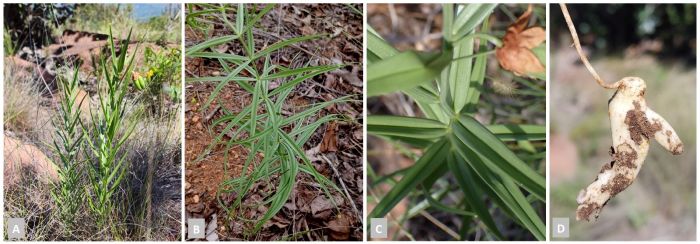
Fig. 1: The habit of Gloriosa rigidifolia showing A: the erect, usually solitary and very rarely branched stems (Photo SP Bester); B: the leaves in whorls of 3–4 at the nodes, clasping the stem (Photo J Kalwij); C: sessile leaf bases without any distinct venation apart from the main vein (Photo D Hoare); D: a side view of the bilobed hypopodial tuber (Photo SP Bester).
The flowers are solitary from the axils of upper leaves, pendent, 8−20 in upper half to third of the flowering stems, usually without overtopping sterile leaves. The pedicels are 6−25 mm long and inserted on one side of leaf base or on internodes.
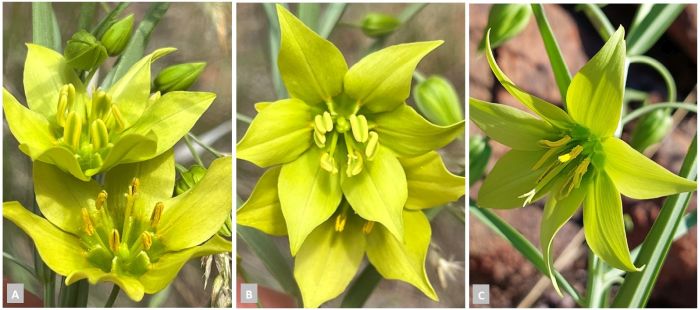
Fig. 2: The flower of Gloriosa rigidifolia. A: Angled side view showing the nectary flaps at the base of the tepals. (Photo L Lindenthal); B: Frontal view of a flower (Photo L Lindenthal); C: Angled side view showing especially the slender style ending in 3 branches (Photo M Popp).
The corolla is shallowly cup-shaped, pale green or dull yellowish green; basally fused, tepals suberect below becoming spreading towards the tips, the lobes ovate to ovate-lanceolate, 13−17 x 6−8 mm, tip acuminate, ± 2 mm long. It contains an oblong nectar cavity at the base flanked with two keeled ciliate appendages. The stamens are suberect, a third the length of the corolla length. The slender filaments are 7−8 mm long and the anthers 5−6 mm long, linear-oblong and opening outwards (away from the axis of the flower). The ovary is obovoid to oblong, 3-lobed, with many ovules. The style is erect, 7−10 mm long, the fused portion 7−8 mm long with a tip branched into three branches about 2 mm long.
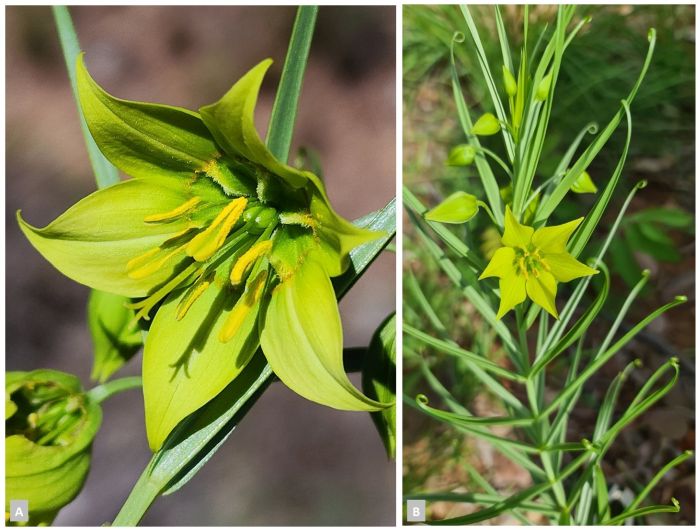
Fig. 3: The flower of Gloriosa rigidifolia. A: Showing the relative length of the ovary to style, the style being much longer than double the length of the ovary. (Photo SP Bester); B: Note especially the tendrils on the leaf tips (Photo SP Bester).
The fruit is an ovoid to ellipsoid capsule, about 18−40 x 10−18 mm at maturity, containing many seeds. The glossy and reddish seeds are rounded, with a thinly fleshy outer membrane, and about 5 mm in diameter.
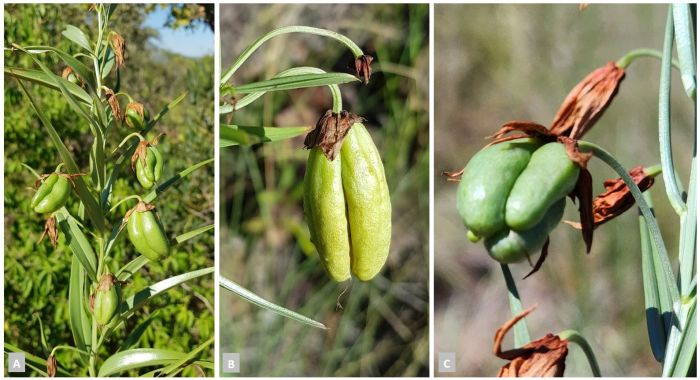
Fig. 4: The fruit of Gloriosa rigidifolia. A: Developing fruits following pollination of the flowers that open successively towards the tip. (Photo SP Bester); B: Side view of a nearly mature fruit showing ovoid shape in outline (Photo SP Bester); C: Fruit viewed from the apex showing the three locules tightly incised (Photo SP Bester).
Conservation Status
Status
Gloriosa rigidifolia is a restricted endemic of the Waterberg Mountain Complex, where extensive areas are protected, and the species is widely distributed there. No major threats have been reported within its range that would support a population decline or indicate severe fragmentation. Therefore, it has been assessed as of Least Concern (LC) by the Red List of South African Plants.
Distribution and habitat
Distribution description
Gloriosa rigidifolia is restricted as a narrow endemic to the Waterberg Plateau in the Limpopo Province where it grows on mostly rocky outcrops in bushveld savanna. It has been recorded from altitudes ranging between 1 000−1 770 m above sea level. Also known as the Waterberg bells because of their typically drooping flowers, individuals of G. rigidifolia are found dispersed widely, never in dense populations. Plants usually flower in midsummer, between December and January, with the fruits developing and bursting open about a month afterwards.
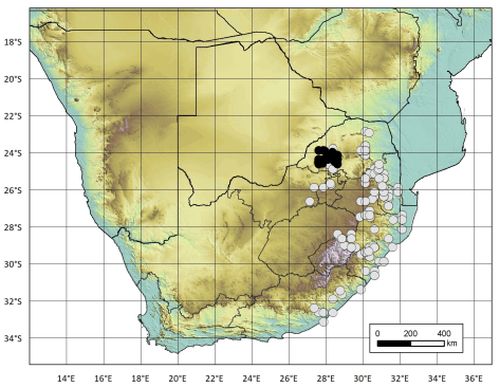
Fig. 5: Distribution of Gloriosa rigidifolia indicated by the black dots.
Derivation of name and historical aspects
History
The genus Gloriosa was initially established by Linnaeus in 1753, and at the time consisting of a single taxon, G. superba. The genus name Gloriosa is from the Latin gloriosus meaning ‘glorious’, ‘famous’ or ‘ostentatious’. The epithet rigidifolia refers to the ridged or pleated leaves of the plant.
The Waterberg bells was previously attributed to the genus Littonia, but in 2007 all members of this genus were moved to Gloriosa after the discovery of G. sessiliflora by Nordal and Bingham in 1998, which showed intermediate traits between the distinguishing characters of Littonia and Gloriosa.
Gloriosa is characterised by the tendrils on the tips of the leaves that are used in most species for climbing, and median nectaries on tepals.
Gloriosa belongs in the crocus family (Colchicaceae). Other members of this family that are well-known to gardeners, include Sandersonia aurantiaca, and the genus Colchicum.
The genus Gloriosa is a small genus, consisting of about 12 species, found in Africa and Asia. There are three species indigenous to southern Africa: Gloriosa superba, G. modesta and G. rigidifolia.
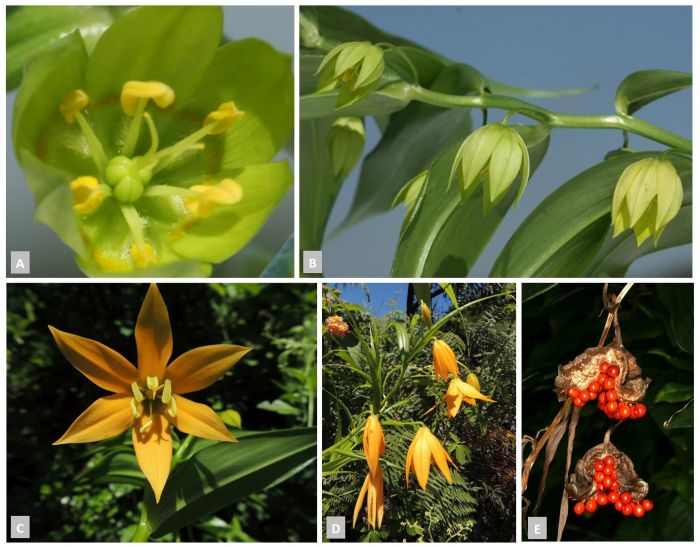
Fig. 6: The morphology of Gloriosa modesta. A: Frontal view of a flower showing deeply divided style branches and faint orange ring at base of the tepals; tepals somewhat closed. (Photo M Koekemoer); B: Side view of a branch showing a green form of this species. (Photo M Koekemoer); C: Orange variant in frontal view. (Photo M Koekemoer); D: Side view of orange flowers on branch tip. (Photo M Koekemoer); E: Dehisced fruit with red sarcotesta. (Photo SAPlants @Wikkicommons).
Ecology
Ecology
The open, rotate flowers are obviously adapted to insect pollination with nectar guides present as keels on the base of the inner side of the tepals. The pendent flowers hint to a melittophily pollination syndrome (bee-pollinated) and occasional visits by pollen-collecting bees from the genus Lassioglossum (Halictidae), were observed by Lyn Wadly. Very little is known about the overall biology of Gloriosa rigidifolia, and this leaves ample room for further research.
The seeds of Gloriosa rigidifolia resemble those of G. modesta. Upon maturity, the fruit bursts open, exposing small, rounded seeds with a thinly fleshy orange testa. It is highly likely that seed distribution occurs through birds, similarly to those of Freesia grandiflora, which inhabits the same habitats as G. rigidifolia (Manning & Goldblatt 2010).
The tendrils of Gloriosa are features used for climbing, but in G. rigidifolia this seems to be a remnant evolutionary trait as the author observes that the plants do not appear to utilise them for climbing per se.
The lack of references, for this and many other South African plant taxa, highlight both the documented and potential uses of Gloriosa rigidifolia, underscoring the importance of further research and conservation efforts for this species. Further research on G. rigidifolia could reveal unique compounds with medicinal properties, contributing to pharmaceutical developments.
Uses
Use
Given the limited specific information on G. rigidifolia, following are uses of related genera or species that may hint to possible similar applications. Thus, based on the predictive nature of taxonomy closely related taxa usually contain similar molecular compounds that act as metabolites used for the treatment not only as traditional medicines but are also for extraction to be used in western medicine. To this extent no literature could be found indicating the direct specific medicinal use of G. rigidifolia, but there are numerous applications from closely related taxa like G. superba that are used for treatments of conditions like antibacterial use; anti-arthritic or gout; anti-cancer; to treat inflammation and pain; and analgesic properties; for barrenness and impotency; for ascites and antispasmodic; compounds from Gloriosa modesta as aphrodisiacs; an as emetics; treatment of skin conditions amongst others.
The proto-alkaloid colchicine suggests that it is restricted to Colchicaceae. Gloriosa superba contains the alkaloid colchicine, which is present in most members of the family Colchicaceae, and from which the name of the compound has been derived. Derivatives of the plant are very poisonous, and incorrect dosage has caused human deaths. Not only have livestock that consumed these plants died, but it has also been reported to be used in both suicide and homicide.
Colchicum and Gloriosa (especially G. superba) are well-known subjects of horticulture and grown in many countries across the world. The possibility of growing G. rigidifolia with its upright stems and multitude of flowers that last a couple of days with new ones open successively over weeks, needs investigation.
Despite the biosynthesis of colchicine, increased industrial demand for both wild and cultivated species of Colchicum, Iphigenia and Gloriosa may eventually place stress even on populations of G. rigidifolia should the source of use be discovered in the locality where it occurs naturally.
Growing Gloriosa rigidifolia
Grow
Grow Gloriosa rigidifolia in fertile, well-composted, sandy soil in a sunny, semi-shaded or lightly shaded position, and water well in spring and summer. It is a good container plant. Keep plants dry in winter or grow them in well-drained soil, as the dormant tubers are prone to rotting.
Gloriosa rigidifolia naturally grows in frost-free areas and is thus sensitive to frost and cold and wet climates. It may also be suitable for coastal gardens.
Gloriosa rigidifolia can best be propagated by seed or division of the tubers. Seeds may be easier to harvest from wild populations as the tubers are usually wedged between rocks in the rocky situations where they grow and easily damaged when extracted.
If you already have plants growing in your garden or in pots, lift and divide the tubers in late winter while the plants are dormant, but just before new growth starts in spring. Be sure to handle the tubers with care as they are delicate and brittle. As they grow slowly, they should be left to grow undisturbed for at least three years before lifting.
Growing Gloriosa rigidifolia from seed is like growing those of G. superba. Sow seeds in spring. Germination is best at warm temperatures between 20º and 25ºC. Remove the fleshy outer coat and soak the seeds in warm water overnight. Plant them in well-drained, sterile potting soil by pressing the seed into the soil, covering them lightly with more soil. Keep the trays moist but never wet. Germination is erratic, generally between 2 weeks to 3 months, but some for much longer. Seedlings can be planted out straight into the garden or a container as soon as they are large enough to handle, or pot them up and grow them on in the nursery. Young plants grow rapidly, but may take several years to flower.
References
- Angiosperm Phylogeny Group. 2016. An update of the Angiosperm Phylogeny Group classification for the orders and families of flowering plants: APG IV. Botanical Journal of the Linnean Society 181(1): 1–20. https://doi.org/10.1111/boj.12385.
- Bester, S.P. & Condy, G.S. 2025. Gloriosa rigidifolia. The Flowering plants of Africa
- Dubey, K.K., Ray, A.R. & Behera, B.K. 2008. Production of demethylated colchicine through microbial transformation and scale-up process development. Process Biochemistry 43(3): 251−257.
- Duke, J.A. 1985. Handbook of medicinal herbs. CRC Press, USA.
- Ebrahim, I. & Manning, J.C. 2022. Gloriosa rigidifolia (Bredell) J.C.Manning & Vinn. National Assessment: Red List of South African Plants. http://redlist.sanbi.org/species.php?species=3993-11.
- Hutchings, A., Scott, A.H., Lewis, G. & Cunningham, A.B. 1996. Zulu medicinal plants: an inventory. University of Natal Press, Pietermaritzburg.
- Kiros, T., Ebu, S.M., Melaku, Y., Tesfa, T. & Dekebo, A. 2023. Isolation and identification of endophytic bacteria and associated compound from Gloriosa superba and their antibacterial activities. Heliyon 9(11): e22104.
- Kwinda, M., Molele, K., Ndlovu, S. & Bester, P. 2024. Handy hands of Groen Sebenza interns. Sanbi Gazette 15: 33−34.
- Larsson, S. & Ronsted, N. 2014. Reviewing Colchicaceae alkaloids — perspectives of evolution on medicinal chemistry. Current Topics in Medicinal Chemistry 14: 274−289.
- Mahajan, Y.A., et al. 2024. Unlocking the genetic and biotechnological potential of Gloriosa superba to enhance its alkaloid production. Industrial Crops and Products: 211: 118144.
- Manning, J. & Ebrahim, I. 2022. Flame-lilies and Christmas Bells: The genera Gloriosa L. and Sandersonia Hook. (Colchicaceae: Colchiceae) in Southern Africa. South African Journal of Botany 151: 976−95.
- Manning, J.C. & Goldblatt, P. 2010. Botany and horticulture of the genus Freesia (Iridaceae). Strelitzia 27. South African National Biodiversity Institute, Pretoria.
- Maroyi, A. & Van der Maesen, L.J.G. 2011. Gloriosa superba L. (family Colchicaceae): Remedy or poison? Journal of Medicinal Plants Research 5(26): 6112–6121.
- Nordal, I. & Bingham, G. 1998. Description of a new species, Gloriosa sessiliflora (Colchicaceae), with notes on the relationship between Gloriosa and Littonia. Kew Bulletin 53: 479−482.
- Nordenstam, B. 1998. Colchicaceae: In: Kubitzki, K. (ed.), The Families and Genera of Vascular Plants. Vol. 3: Flowering plants: Monocotyledons: Lilianae (except Orchidaceae): 175−185. Springer, Berlin, Heidelberg.
- Notten, A. 2015. Gloriosa superba L. (Colchicaceae). PlantZAfrica. Online. https://pza.sanbi.org/gloriosa-superba.
- Retief, E. & Herman, P.P.J. 1997. Plants of the northern provinces of South Africa: keys and diagnostic characters. Strelitzia 6. National Botanical Institute, Pretoria.
- Trease, G.E. & Evans, W.C. 1983. Pharmacognocy. 12th ed. Bailliere Tindall, London.
- Van Wyk, B.-E. & Gericke, N. 2000. People's plants. Briza Publications, Pretoria.
- Vinnersten, A. & Larsson, S. 2010. Colchicine is still a chemical marker for the expanded Colchicaceae. Biochemichal Systematics and Ecology 38(6): 1193−1198.
- Vinnersten, A. & Manning, J.C. 2007. A new classification of Colchicaceae. Taxon 56: 171–178.
- Wadley, L., Willemse, L., Baytopp, K., Swart, J., Heymans, J. Tarboton, W. & Tarboton, M. 2021. Wild Flowers of the Waterberg. Mapula Trust.
- Watt, J.M. & Breyer-Brandwijk, M.G. 1962. The medicinal and poisonous plants of southern and eastern Africa , edn 2. Livingstone, Edinburgh & London.
Credits
SP Bester
National Herbarium, Pretoria,
Foundational Research and Services Division, Botanical Research Directorate
December 2024
Acknowledgements: ththe author thanks the photographers J. Kalwij, D. Hoare, L. Lindenthal, M. Popp, M. Koekemoer and SAPlants, for allowing the use of their images.
Plant Attributes:
Plant Type: Bulb, Perennial
SA Distribution: Limpopo
Soil type: Sandy, Loam
Flowering season: Early Summer, Late Summer
PH:
Flower colour: Green, Yellow
Aspect: Full Sun, Morning Sun (Semi Shade), Afternoon Sun (Semi Shade)
Gardening skill: Average
Special Features:
Horticultural zones
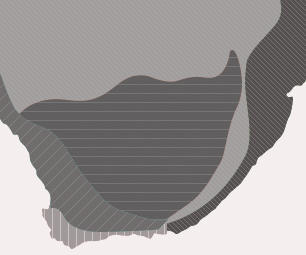







Rate this article
Article well written and informative
Rate this plant
Is this an interesting plant?
Login to add your Comment
Back to topNot registered yet? Click here to register.